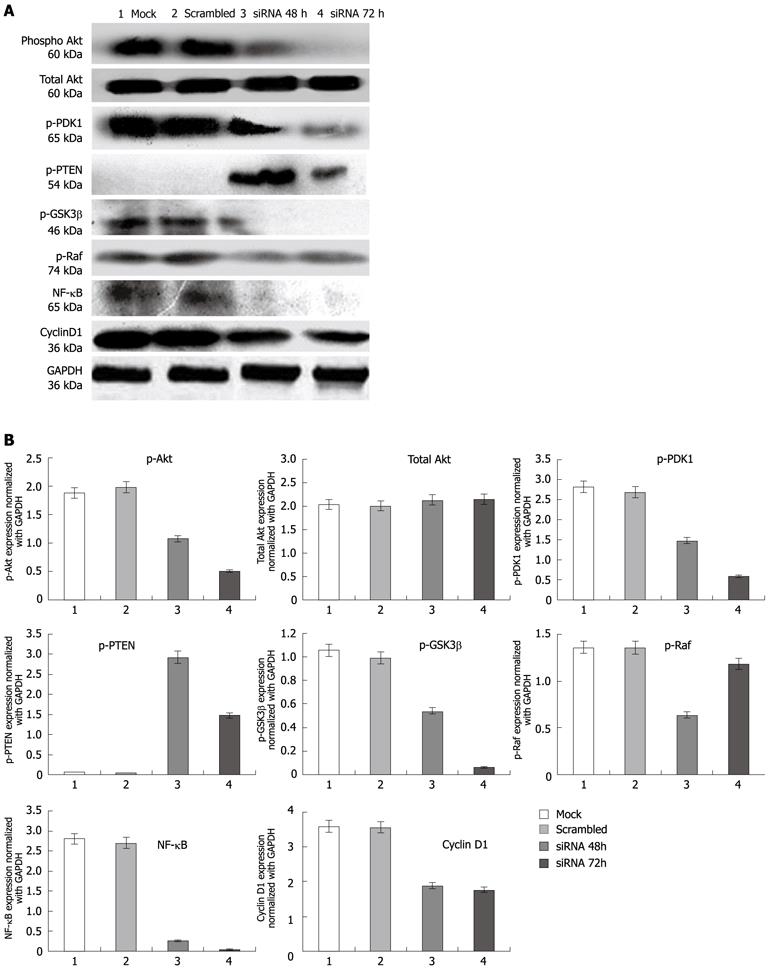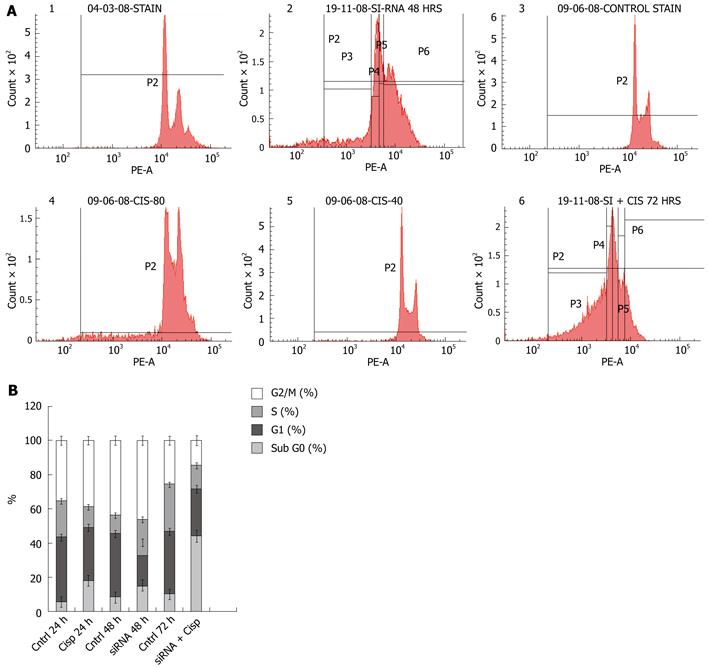Copyright
©2012 Baishideng Publishing Group Co.
World J Gastroenterol. Aug 21, 2012; 18(31): 4127-4135
Published online Aug 21, 2012. doi: 10.3748/wjg.v18.i31.4127
Published online Aug 21, 2012. doi: 10.3748/wjg.v18.i31.4127
Figure 1 Small interfering RNA-targeting TC21/R-Ras2 was transfected in TE13 cells.
A: Reverse transcriptase-polymerase chain reaction (RT-PCR) analysis: Small interfering RNA (siRNA)-targeting TC21/R-Ras2 was transfected in TE13 cells in a dose-dependent manner. After 48 h and 72 h, cells were lysed, RNA was isolated and the mRNA level was determined semiquantitatively by RT-PCR using TC21-specific primers; B: Bar diagram showing fold change in level of TC21 transcripts after TC21 knockdown.
Figure 2 TC21 protein and extracellular signal-regulated kinase 2 level.
A: Western blotting was carried out using specific antibody; the panel shows inhibition of TC21 protein compared with cells without transfection or transfection with a negative control siRNA (scrambled sequence); B: Bar diagram showing more than 95% decrease in TC21 protein level after TC21 knockdown compared with untreated mock and nonspecific scrambled sequence; C: Western blotting analyses show inhibition of ERK2 protein by targeted siRNA as positive control; D: Bar diagram showing more than 98% decrease in ERK2 level after MAPK knockdown compared with untreated mock and nonspecific scrambled siRNA sequence. ERK: Extracellular signal-regulated kinase; MAPK: Mitogen-activated protein kinase; GAPDH: Glyceraldehyde-3-phosphate dehydrogenase.
Figure 3 Expression of proteins in esophageal squamous cancer cells TE13 and compared with control.
A: Expression analysis of protein kinase B (pAkt), total Akt, protein Glycogen synthase kinase 3β (pGSK3β), pRaf, protein Phosphoinositide-dependent kinase-1 (pPDK1), phosphatase and tensin homolog (pPTEN), nuclear factor-κB (NF-κB) and cyclin D1 proteins compared in esophageal squamous cancer cells TE13. Lane 1: Mock; Lane 2: Scrambled (non-target siRNA); Lane 3: TC21 siRNA transfected for 48 h; Lane 4: TC21 siRNA transfected for 72 h; B: Bar diagram showing relative levels of proteins in comparison with control protein GAPDH. GAPDH: Glyceraldehyde-3-phosphate dehydrogenase.
Figure 5 Cell cycle analyses.
A: TC21-knockdown cells (20 nmol siRNA for 48 h) were treated with cisplatin (8 μg/mL) for 24 h and cell cycle analysis was performed by labeling cells with DNA binding dye propidium iodide. The panel shows 1: DNA histograms of mock-transfected TE13 cells for 48 h; 2: TE13 cells transfected with TC21 siRNA for 48 h showing increased cell death; 3: TE13 cells without transfection for 24 h; 4: TE13 cells were treated with cisplatin alone for 24 h; 5: TE13 cells without transfection for 72 h; 6: TE13 cells were transfected with TC21siRNA for 48 h for optimal knockdown followed by cisplatin at 8 μg/mL for 24 h; B: Stacked bar graph depicts the cell cycle distribution. Data presented here as mean of percentage events from 3 independent experiments.
Figure 4 Cell viability assay.
TE13 cells were treated with cisplatin in a dose-dependent manner for 24 h. Cell viability was determined using the MTT assay, LD50 was found to be 9 μg/mL. Further treatment with cisplatin was carried out at less than the LD50 dose.
- Citation: Hasan MR, Chauhan SS, Sharma R, Ralhan R. siRNA-mediated downregulation of TC21 sensitizes esophageal cancer cells to cisplatin. World J Gastroenterol 2012; 18(31): 4127-4135
- URL: https://www.wjgnet.com/1007-9327/full/v18/i31/4127.htm
- DOI: https://dx.doi.org/10.3748/wjg.v18.i31.4127













